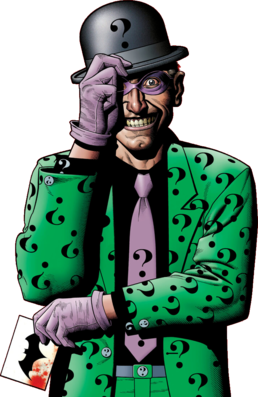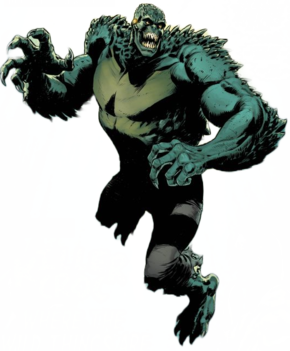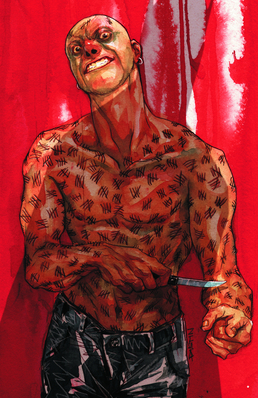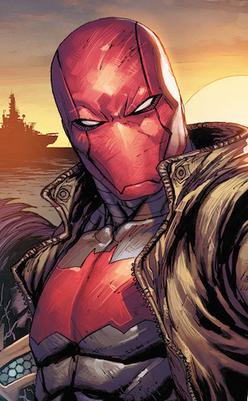Related Research Articles

The Elizabeth Arkham Asylum for the Criminally Insane, commonly referred to as Arkham Asylum, is a fictional psychiatric hospital/prison, named after the city of Arkham which appeared first in the stories of H. P. Lovecraft, and later appearing in American comic books published by DC Comics, commonly in stories featuring the superhero Batman. It first appeared in Batman #258, written by Dennis O'Neil with art by Irv Novick. The asylum serves as a (forensic) psychiatric hospital for the Gotham City area, housing patients who are criminally insane, as well as select prisoners with unusual medical requirements that are beyond a conventional prison's ability to accommodate. Its high-profile patients are often members of Batman's rogues gallery.

The Scarecrow is a supervillain appearing in American comic books published by DC Comics. Created by Bill Finger and Bob Kane, the character first appeared in World's Finest Comics #3. He has become one of the most enduring enemies of the superhero Batman and belongs to the collective of adversaries that make up his rogues gallery.

The Riddler is a supervillain appearing in American comic books published by DC Comics. The character was created by Bill Finger and Dick Sprang, and debuted in Detective Comics #140 in October 1948. He has become one of the most enduring enemies of the superhero Batman and belongs to the collective of adversaries that make up his rogues gallery.

Bane is a supervillain appearing in American comic books published by DC Comics. Created by writer Chuck Dixon and artist Graham Nolan, he made his debut in Batman: Vengeance of Bane #1. Bane is usually depicted as a dangerous adversary of the superhero Batman, and belongs to the collective of enemies that make up Batman's rogues gallery. Possessing a mix of brute strength and exceptional intelligence, Bane is often credited as the only villain to have "broken the bat", defeating him both physically and mentally. Bane went on to kill Alfred Pennyworth in 2019 during the City of Bane storyline. He is the son of another Batman enemy, King Snake and has a clone/daughter named Vengeance, introduced in 2021.

Killer Croc is a supervillain appearing in American comic books published by DC Comics. Created by Gerry Conway, Don Newton and Gene Colan, the character was introduced in Batman #357. He has become one of the most enduring enemies of the superhero Batman and belongs to the collective of adversaries that make up his rogues gallery.

Victor Zsasz, also known as Mr. Zsasz or simply Zsasz, is a supervillain appearing in comic books published by DC Comics. The character first appeared in Batman: Shadow of the Bat #1. He is a sadomasochistic and psychopathic serial killer who carves a tally mark onto himself for each of his victims. A recurring adversary of the superhero Batman, Zsasz belongs to the collective of enemies that make up Batman's rogues gallery.

Egghead is a fictional character created for the 1960s Batman television series. Played by Vincent Price, the character was identifiable by his pale bald head and white and yellow suit. He believes himself to be "the world's smartest criminal", and his crimes usually have an egg motif to them; he also includes egg-related puns in his speech and uses various egg-themed weapons. Additionally, Egghead used deductive reasoning to deduce Batman's secret identity.

Firefly is a supervillain appearing in American comic books published by DC Comics. Created by France Herron and Dick Sprang, he made his debut in Detective Comics #184. Initially portrayed as a criminal who utilized lighting effects to commit robberies, Firefly was later reimagined as a sociopathic pyromaniac with an obsessive compulsion to start fires following Crisis on Infinite Earths' reboot of the DC Universe in the 1980s. This darker depiction of the character has since endured as one of the superhero Batman's most recurring enemies and belongs to the collective of adversaries that make up his central rogues gallery.

Hush is a supervillain appearing in American comic books published by DC Comics. Created by Jeph Loeb and Jim Lee, the character first appeared in Batman #609 in January 2003 as part of the twelve-issue storyline Batman: Hush. Hush serves as a criminal foil to the superhero Batman and belongs to the collective of adversaries that make up his rogues gallery.

Calendar Man is a supervillain appearing in American comic books published by DC Comics, as an enemy of the superhero Batman, belonging to the collective of adversaries that make up Batman's rogues gallery. Calendar Man is known for committing crimes that correspond with holidays and significant dates. He often wears costumes to correlate with the date of the designated crime. His name, in itself, is a joke, referencing both the Julian and Gregorian calendars. In his debut, the character was presented as a joke villain, but in later years, writers developed Calendar Man as a dark, disturbed criminal who toys with Batman.
Blockbuster is the name of four supervillains and a criminal organization appearing in American comic books published by DC Comics. The first iteration was an adversary of Batman and Robin, while the second served as one of Nightwing's greatest enemies. The latest version first appeared in the pages of the series 52 wherein he is directed into battle against Lex Luthor's team of superheroes.

The Red Hood is an alias used by multiple characters appearing in American comic books published by DC Comics. The identity was first used in the 1951 story line "The Man Behind the Red Hood!", which provides the earliest origin story for the Joker. The storyline depicts an unnamed criminal wearing a red dome-shaped hood who, after a chance encounter with Batman, is disfigured by chemicals and becomes insane, giving birth to his future Joker persona.

Amygdala is a supervillain appearing in American comic books published by DC Comics, who is an opponent of Batman. He has reduced mental capacity, near superhuman strength and endurance, and is prone to outbursts of violence due to medical experimentation on his brain, chiefly the removal of his amygdala. Amygdala is briefly referenced in an article by Joseph LeDoux, a neuroscientist and expert in the role of the anatomical amygdala in fear processing, as testament to popular interest in the brain area.

Cornelius Stirk is a fictional character appearing in DC Comics. He is a cannibalistic supervillain with the ability to cause fear or hallucinations through telepathy and appears as a recurring adversary of Batman.

Batman Confidential is an American monthly comic book series from DC Comics which debuted on December 6, 2006 and concluded on March 2, 2011.

The Joker, a supervillain in DC Comics and archenemy of the superhero Batman, has appeared in various media. WorldCat records over 250 productions featuring the Joker as a subject, including films, television series, books, and video games. Live-action films featuring the character are typically the most successful.

Batman is a fictional character appearing in American comic books published by DC Comics. Created by Geoff Johns (writer) and Andy Kubert (artist), he made his first appearance in Flashpoint #1. He is a hardened version of Thomas Wayne seen in the alternate timeline comic Flashpoint (2011) whose son was killed instead of Martha Wayne and himself, eventually helping Barry Allen/The Flash defeat Eobard Thawne. His character returned to the main DC Universe in DC Rebirth as a revived amalgamation of his original self that was killed by Joe Chill and the Flashpoint version of Batman that was killed in "The Button", a storyline revolving around the "Smiley-face" button from Watchmen.

The Riddler, a supervillain in DC Comics and an adversary of the superhero Batman, has been adapted into numerous forms of media, including feature films, television series, and video games. The character has been portrayed in live-action by Frank Gorshin and John Astin in the 1960s television series Batman, Jim Carrey in the 1995 film Batman Forever, Cory Michael Smith in the 2014 Fox series Gotham, and Paul Dano in the 2022 film The Batman. Actors who have voiced the Riddler include John Glover in the DC Animated Universe, Robert Englund in The Batman, and Wally Wingert in the Batman: Arkham video games.

The fictional supervillain Penguin, created by Bob Kane and Bill Finger, made his first appearance in Detective Comics #58. Since then, he has been adapted into other forms of media, including feature films, television series, and video games.
References
- ↑ "Victor Buono". IMDb .
- ↑ Batman Confidential #26–28 (April–June 2009). DC Comics.
- ↑ The Riddler: Year of the Villain #1 (September 2019). DC Comics.